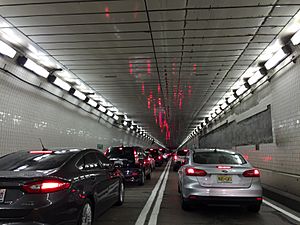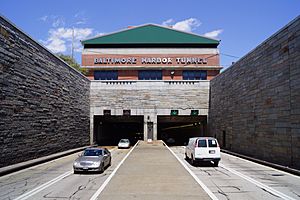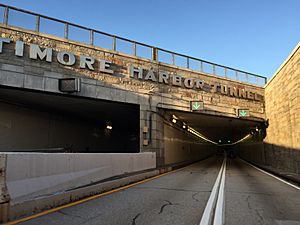Baltimore Harbor Tunnel facts for kids
 |
|
| Baltimore Harbor Tunnel, traveling northbound on I-895 | |
| Overview | |
|---|---|
| Location | Patapsco River, Baltimore, Maryland, U.S. |
| Coordinates | 39°15′15″N 76°34′16″W / 39.25417°N 76.57111°W |
| Route | |
| Operation | |
| Operator | Maryland Transportation Authority |
| Toll | Passenger cars: $3 Maryland E-ZPass $4 non-Maryland E-ZPass $6 Video toll |
| Technical | |
| Length | 7,650 ft (1.45 mi; 2.33 km) |
| Number of lanes | 4 |
| Tunnel clearance | 14 ft (4.3 m) |
The Baltimore Harbor Tunnel is a pair of two-lane road tunnels. These tunnels carry I-895 under the Patapsco River. They are located southeast of downtown Baltimore, Maryland.
Contents
About the Tunnel
The Baltimore Harbor Tunnel is actually two separate tunnels. Each tunnel is about 7,650 feet long, which is almost 1.5 miles! They stretch from the south side of the Patapsco River to the north side, near Dundalk.
Tunnel Design
Each tunnel is 22 feet wide and 14 feet high. This allows two lanes of traffic to pass through. The fastest you can drive inside the tunnel is 50 miles per hour. Sometimes, if there's roadwork or an emergency, traffic might go both ways in one tunnel. This helps keep things moving safely.
Air and Depth
Both ends of the tunnels have special buildings. These buildings hold 32 large fans! These fans work to bring fresh air into the tunnels. They also push out the old air. The tunnels themselves go deep under the water. They can be anywhere from 50 feet to 101 feet below the ground.
Paying to Use the Tunnel
Using the tunnel costs money, which is called a toll. Since July 1, 2015, cars pay $4.00 if they use cash. If you have an E-ZPass, it costs $3.00. You pay this toll when you enter the tunnel.
In March 2020, the way tolls were collected changed. Now, you don't stop to pay cash. Instead, tolls are paid electronically. You can use your E-ZPass or a system called "Video Tolling." Video Tolling uses cameras to read your license plate. This change was made permanent in August 2020.
Tunnel History
The Baltimore Harbor Tunnel was designed by expert engineering companies. They specialized in building tunnels.
How it was Built
Building the tunnel was a huge project! Workers put 21 large sections of the tunnel into the harbor. Each section was about 310 feet long. They were carefully lowered into a trench that was dug in the riverbed. Then, rocks and dirt were used to hold them in place. The first of these big tunnel pieces was placed on April 11, 1956. Other parts of the tunnel were built by digging a trench, building the tunnel, and then covering it up. The whole project cost about $150 million back then.
Opening Day
The tunnel officially opened on November 29, 1957. Maryland Governor Theodore McKeldin was there, along with 4,000 people watching. The first toll for a regular car was 40 cents. On its first day, about 10,000 cars used the tunnel! It was a very busy day. The tunnel even had its first car accident just 15 minutes after opening.
Impact and Upgrades
The tunnel was a big success. It helped reduce traffic in Baltimore by a lot. It removed 51 traffic lights for cars driving straight through the city. But as more and more people used it, traffic still grew. So, another tunnel, the Fort McHenry Tunnel, was built and opened in 1985. This new tunnel helped complete Interstate 95 in Maryland.
After the Fort McHenry Tunnel opened, the Harbor Tunnel was closed for major repairs. This work started in March 1987 and finished by 1990. In November 2007, the tunnel celebrated its 50th birthday!
In November 2018, the Maryland Transportation Authority started a big project. They replaced bridges north of the tunnel. They also spent $28 million to fix and improve the tunnel itself. This work was mostly finished by December 2020.
After the Francis Scott Key Bridge collapse on March 26, 2024, the Harbor Tunnel became a very important route. It helped redirect traffic, especially for drivers and trucks that did not carry dangerous materials.




